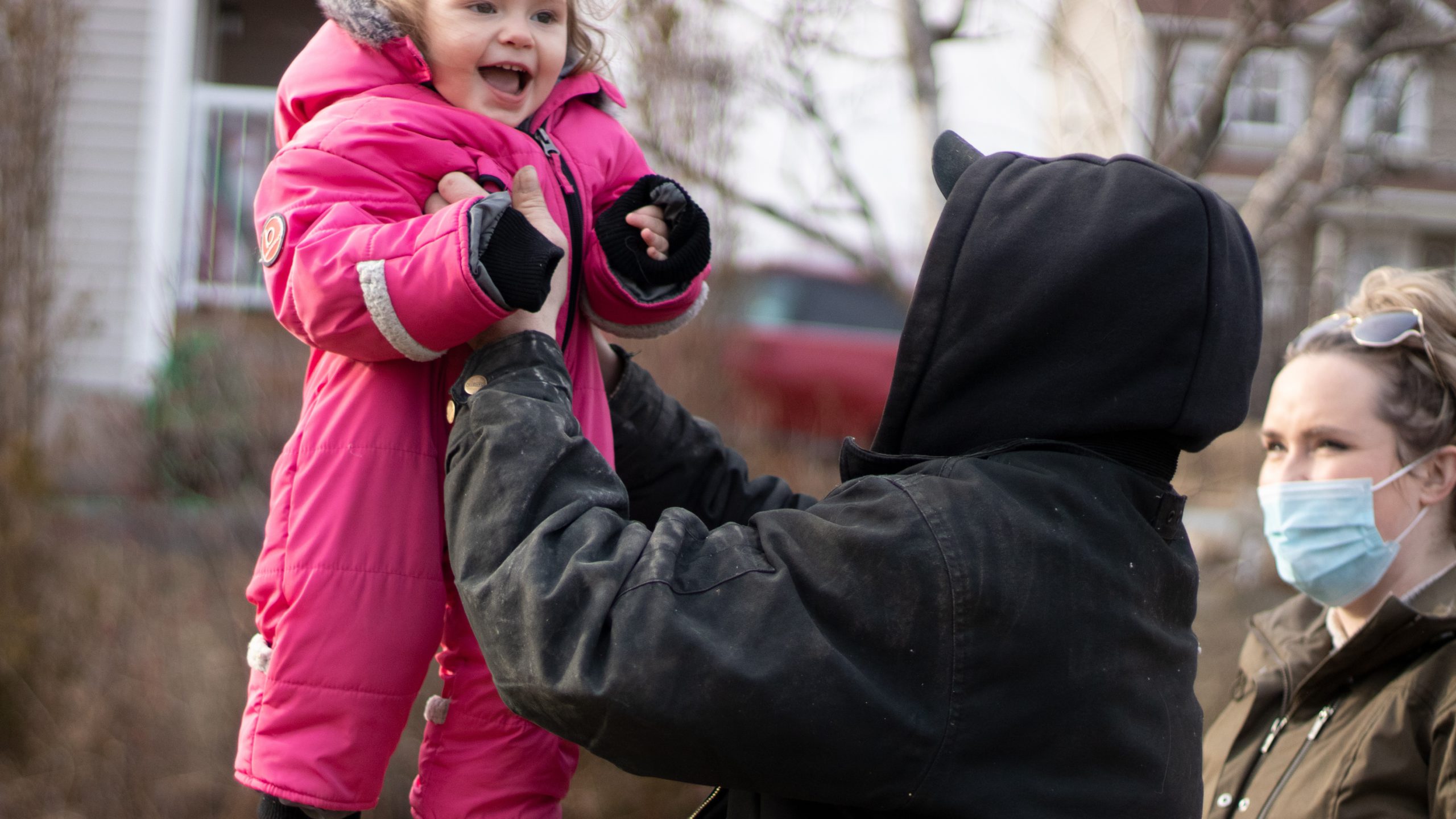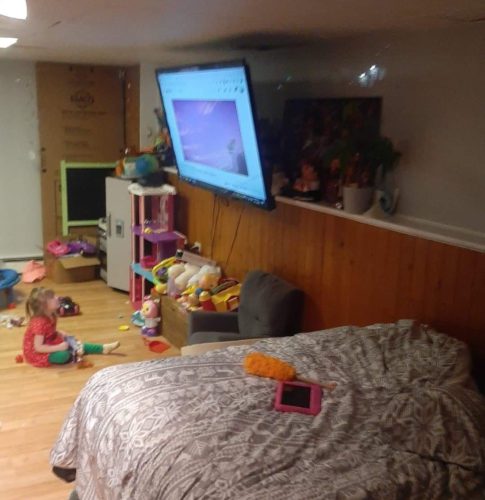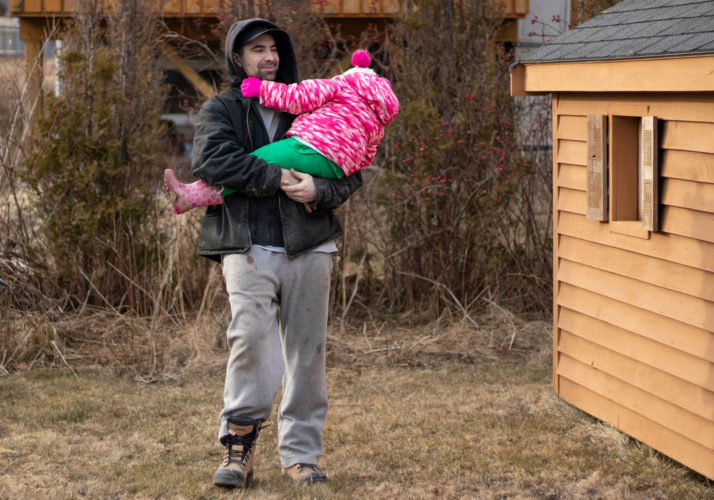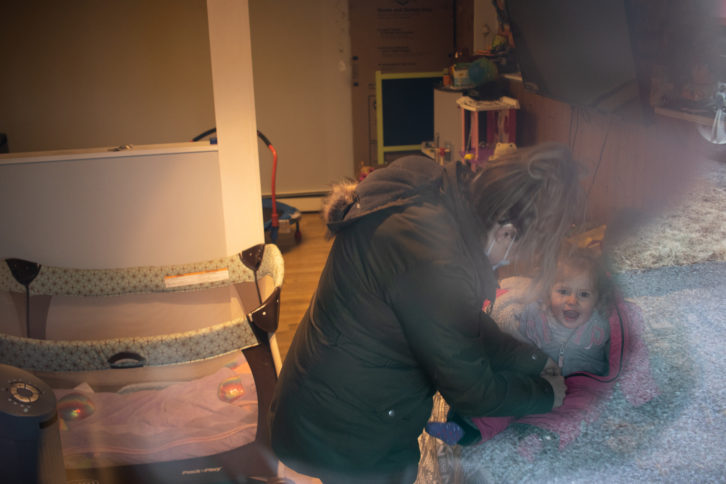Come home or high water

caption
Steph Kenny and her family have been living with her mother since November, after their landlord told them he was selling the home they were renting.How multi-generational living is keeping some families afloat during the pandemic
Steph Kenny wipes her eyes on her shirt cuff as she talks about the home her family left behind. She’s folded up on the couch, surrounded by boxes filled with toys and fragments of her family’s life, in the basement where they now live.
Their former Woodlawn home is just a series of memories: the basement full of bikes, a swing set and a bouncy castle; afternoons spent in the backyard with the family who lived upstairs; brisk mornings, walking her daughter to school.
In July 2020, Kenny’s landlord told the family he was having the home’s value assessed.
“I was basically having a panic attack,” she says “I was like, ‘we’re in a pandemic. Are you selling the house?’”
The landlord told the family not to worry, he was just having it assessed. Two weeks later, they got an email: in 48 hours the house was being listed. He offered them $1,000 if they moved out by the end of November.
Kenny turns her face away as she weeps, her messy blonde bun dancing with the quiver of her voice. Her four-and-a-half-year-old daughter, who’s been gleefully shrieking, playing with her little sister, skips over and tugs innocently at her arm.
“Why are you crying?”
“I’m talking about why we moved here,” she tells her. The family has been living with Kenny’s mom in Eastern Passage since November.
“I felt like I was taking (my daughters’) home away.”Steph Kenny
Kenny’s family is among the 1.5 million Canadians who have moved in with parents during the COVID pandemic. But multi-generational living isn’t new in Canada. Between 2001 and 2016, multi-generational households – households with three generations of the same family – were the fastest growing living situation in Canada, increasing by 37.5 per cent, according to Statistics Canada. In 2016, 6.3 per cent of all Canadians lived in a multi-generational home. That’s 2.2 million people. Households that weren’t multi-generational rose by 27 per cent in the same period.

caption
Kenny’s four-year-old daughter watches television in the rec room that doubles as a bedroom for Kenny, her partner, and their two-year-old daughter.Kenny and her partner contacted the Residential Tenancies Program. They were told the landlord couldn’t kick them out of the house. By that time, they’d already rented a storage unit and moved some of their belongings. Besides, Kenny was too upset to stay. They hunted for a new apartment, but everything was too expensive or didn’t meet their needs.
“I felt like I was taking (my daughters’) home away,” says Kenny.
The family of four now share two rooms: a rec room and one bedroom. Kenny’s eldest daughter got the bedroom. Kenny and her partner sleep in the rec room, along with their youngest daughter. The space won’t fit a crib – she uses a playpen. They have a half bathroom downstairs. They share a shower and kitchen with Kenny’s mother, who lives upstairs.
Generation Boomerang
The number of young adults living with parents has been on the rise since 1981, according to the Vanier Institute of the Family, a not-for-profit organization. Adults in their twenties living with parents increased by 55 per cent between 1981 and 2016. Census data also shows a growing number of people in their thirties are opting to live with family. In the 15 years between 2001 and 2016, the number of people aged 30 to 34 living with a parent grew from 11 per cent to 14 per cent.
They’ve been nicknamed the “boomerang generation.”
When the pandemic began, 24-year-old Taylor Magnus was finishing her nursing degree in Kingston, Ontario. She had plans to emigrate to America after graduation, where she could finally live full-time with her husband.
“I was supposed to be moving on with my life.” But With the Canada-U.S. border closed, her lease running out and no affordable apartments to be found, Magnus boomeranged. She moved back to Picton, Ontario with her parents.
Living with family proved tough. She and her parents shared an open concept living space, where interaction was unavoidable – unless she hunkered down in her bedroom. The stress of the pandemic and cramped quarters brought long-standing family tensions bubbling to the surface.
“It just wasn’t healthy for our relationship,” she says.
By August, things had escalated. When her parents decided to move, she chose not to go with them. Magnus says she loves her parents but didn’t want to feel like she was freeloading in their home.
Canadians struggling financially
Finances have been a major motivation for cohabiting with family. And COVID has only made personal finances tighter.
Adriana Molina, a communications spokesperson for Credit Canada, a not-for-profit credit counselling agency, knows how tough it can be to get ahead, especially with the pandemic affecting jobs.
“Unfortunately, because most Canadians are living paycheck-to-paycheck, their budgets just don’t account for savings, or at least enough savings for an emergency, such as a divorce or you getting sick or getting laid off.”
In 2020, Canada’s unemployment rate rose to 9.5 per cent. This was up from 5.7 per cent in 2019. This number was slightly higher in Nova Scotia, where the unemployment rate rose to 9.6 per cent in 2020.
“Unfortunately, because most Canadians are living paycheck-to-paycheck, their budgets just don’t account for savings, or at least enough savings for an emergency,”Adriana Molina, Credit Canada
Kenny works part-time in retail. She used to work full-time, but after her daughters arrived, it made more financial sense for her to stay home. Her full-time income wouldn’t even cover the cost of daycare,
Her partner works 12- to 14-hour days, saving for a down payment on a home of their own.
While many Canadian’s are struggling financially, among the most in debt are post-secondary students and recent graduates.
According to a May 2020 online crowdsourcing data collection on the impacts of the pandemic on post-secondary students, two-thirds of student participants reported they were extremely or very concerned about having no job prospects in the future.
“It takes (post-secondary graduates) years, not just six months, to get a job that’s enough to maintain their monthly expenses; and then also start to pay off this student debt,” Molina says.
Molina says because so many Canadians are living paycheck-to-paycheck, the national debt to income ratio is rising.
The average Canadian post-secondary graduate, holding a bachelor’s degree in 2015, carried $28,000 in student debt. These massive loans mean young adults are delaying things like home ownership, simply because they can’t afford it. And, in some cases, moving in with family so they don’t have to choose between exorbitant rents or repaying their loans.
Rental market likely to remain tight
According to the Canadian Mortgage and Housing Corporation’s 2020 report on rental markets. Halifax’s vacancy rate has been steadily declining since 2015. The average rent for a two-bedroom jumped four per cent in 2020, despite vacancy rates almost doubling, from 0.9 per cent to 1.9 per cent.
For families like Kenny’s, who would need a three-bedroom rental, the average price tag was $1,455 per month – over $500 more per month than their last home.
With education moved online, students weren’t flocking to Halifax in 2020 as they would in a normal year. Kevin Ndoro, a senior analyst with the CMHC, says this is likely why Halifax’s vacancy rate is now on the rise. He also noted the pandemic slowing international migration to the area.
While there’s no magic number considered to be a healthy vacancy rate for cities, Halifax used to sit around four per cent each year, Ndoro says.
Despite the rising vacancy rate, he says it’s likely Halifax’s rents will continue to increase, and vacancy rates will stay low over the next few years. He points to provincial and federal government plans to increase the number of international immigrants, which could increase demand as the pandemic eases.
“There is supply in the pipeline. It’s just that, unlike demand, somebody can get up and move to Halifax in a heartbeat, but to build … multi-unit structures (is) taking on average, two years.”
Nova Scotia’s real estate market could be adding pressure to the rental market.
“It’s taking a lot longer for people to move from rental to housing,” Ndoro says. “So, they tend to stay in rental longer than they would have otherwise.”
The lack of movement keeps vacancy rates low.
Houses in the Halifax region have been selling for well over asking price, a trend making Kenny worry how long it will take her family to save enough to get a home of their own.

caption
Kenny’s partner has been working 12- to 14-hour days to save for a down payment toward a home.The average home in Halifax sold for $340,096 in February 2021 – a 30.4 per cent increase year-over-year, according to the Nova Scotia Association of Realtors.
Transitioning
For some, moving in with family provides welcome relief to financial and housing woes. But University of British Columbia psychology professor Jennifer Vadeboncoeur says it can be difficult for families to adapt to multi-generational and two-generation living.
“The idea that there wouldn’t be a transition, that this will be easy, that this won’t take a little bit of work or a little bit of intention or thoughtfulness, I think is one of the places where sometimes tensions do emerge.”
Differences of opinion on pandemic safety, parenting and household chores are just a few of the ways different generations might clash when sharing a home.
It can help make the transition smoother and avoid conflict to talk – ideally before moving in – about everyone’s role, responsibilities and expectations within the new household, Vadeboncoeur says.
While having this conversation early is best, it’s not always possible. Living situations can change fast, and emotions can run high.
“There might be a sense of loss, if I’ve lost my housing, if I’ve lost my job or a loss of independence for all these events,” she says.
In these cases, allowing everyone time to adjust to the changes before discussing expectations can help prevent conflict.
Vadeboncoeur also stresses the importance of gratitude.
“I think those small signs of gratitude, those small acknowledgments actually go a really long way with managing some of the new tensions that might crop up.”
Jane Isay, author of the book Walking on Eggshells, has studied the delicate relationship between adult children and parents. She says being flexible about expectations can help families co-exist.
“I think everybody needs to step back a bit,” she says. “The rules of the house that the grown children may not abide by, maybe they’re not so important.”
If families can navigate the new waters of living together as adults with different preferences and values, Vadeboncoeur says there are benefits to living together beyond finances. Multi-generational households allow grandparents and grandchildren more opportunity to create strong, lasting bonds.
“A beautiful way to live”
In 2020, Elizabeth Renzetti, wrote about her experience living multi-generationally. The Globe and Mail columnist and feature writer spent her teenage years living with her mother and grandmother in Toronto.
“It was economic, but I think they also just really liked each other’s company,” she says in an interview. “They were always close; they got along; they were good for each other.”
Her own mother and father had also lived with her paternal grandparents as a young couple. Her father’s family is Italian, a community where multi-generational living is more common and often considered the norm. Renzetti points out not all cultures in Canada stigmatize living with family, but it does exist, particularly in pop culture and films.
“It’s just such a cheap way of indicating somebody hasn’t really become a full adult yet,” she says. “But I think once the stigma is removed, people will see that it’s actually quite a beautiful way to live – or can be.”
When Renzetti and her husband lived in England, raising their own children, her mother would live with them for three months at a time – the longest she could legally stay as a non-citizen.
“She was invaluable,” says Renzetti. “She saved me from going crazy on my own with two small children because she just did so much for me.”
A home to call their own
Stories suggesting the pandemic is a chance to re-evaluate our thinking about the multi-gen home are abundant. But Renzetti says choosing to live multi-generational is different than being forced by necessity.
“This (year) is not a good example of what the experience can be.”

caption
Kenny is looking forward to warmer weather so she and the family can get outside more.Life hasn’t been normal. Going to work, visiting friends and going out would all normally offer families some reprieve from one another.
For now, Kenny and her family are still living with her mother. But she hopes soon they’ll have enough money for a down payment on a mortgage.
“I just keep thinking ‘it’s all going to be a memory,’” Kenny says, “Hopefully we’ll have a house one day.”


B
Beth Hodgson
M
Morgan Boutilier